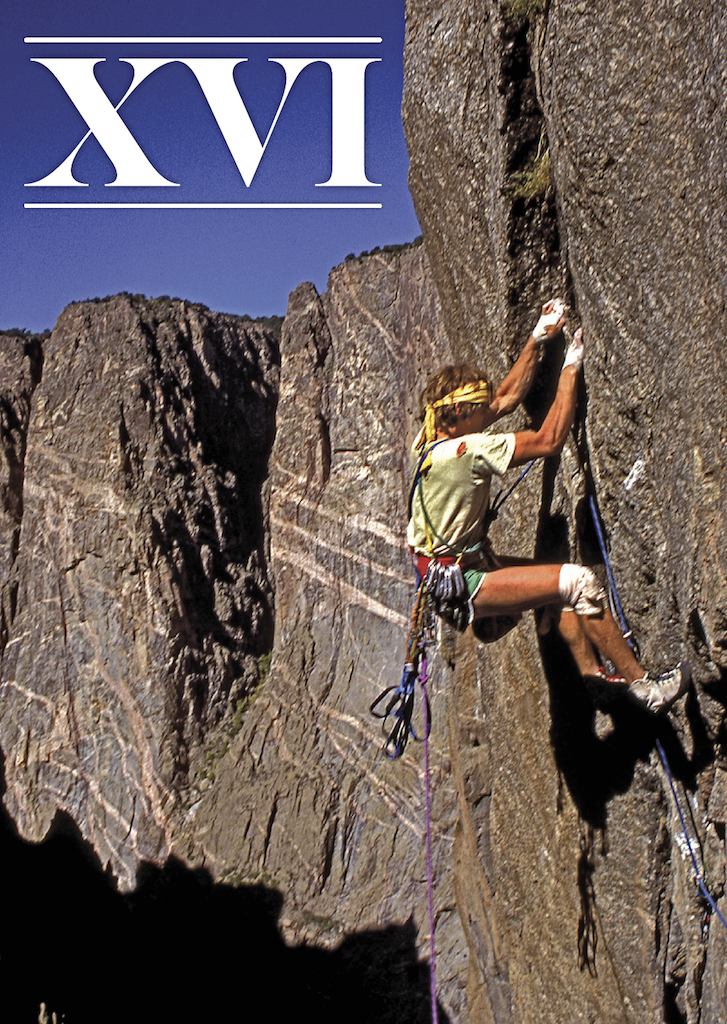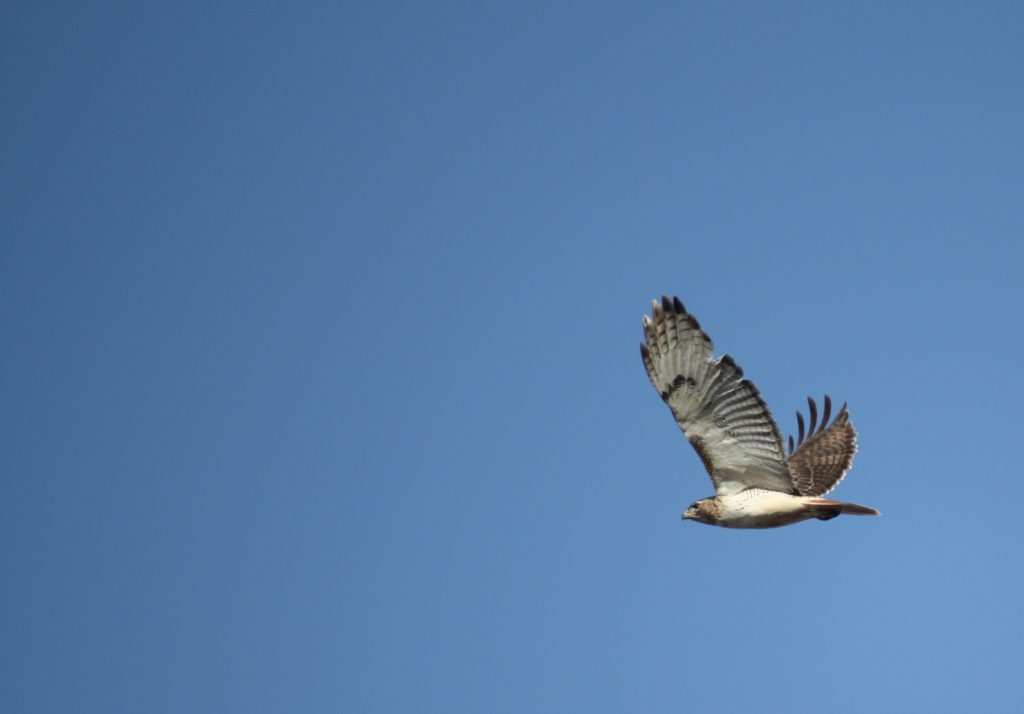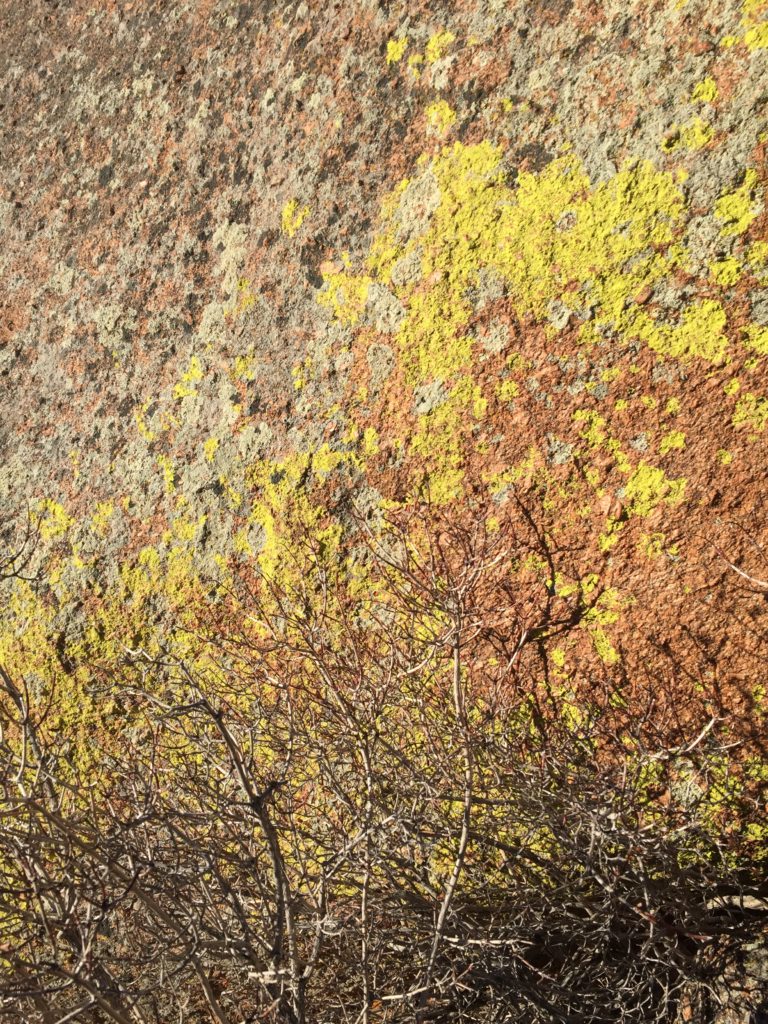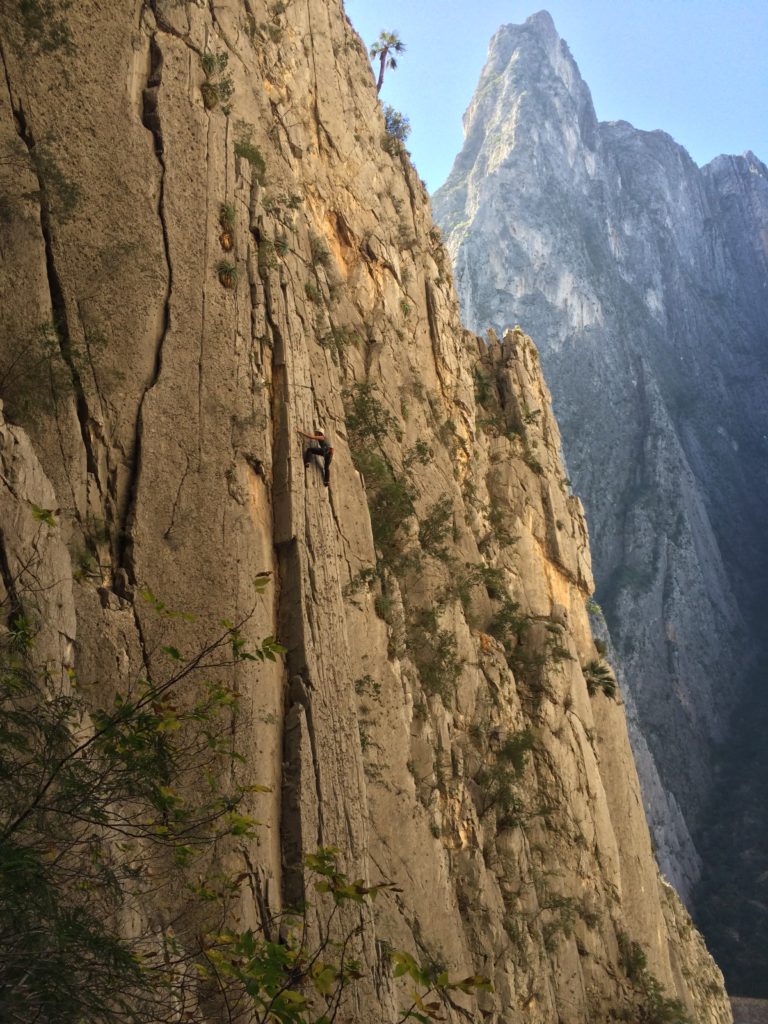June’s humid breath settles in waves over the Mount Washington Valley as the sun dips low in the west. A shadow Cathedral Ledge pools at the base of the real one, growing long toward the chalets and the strawberry fields as I belay my partner up behind me. The air is heavy—with evening promising little reprieve—so I refresh myself in the vision of strawberries fragrant enough to taste.
by Birch Malotky published in Volume 16, now available. Banner photo of the author by Alexandra Roberts

Through the thick air, over the rasping of rope taken up, comes sudden, startling clarity. A bouquet of notes tumbles through the foliage, incandescent. They bloom in midair, throwing rainbows of light on the trees like precious stones faceted into brilliance. They cascade down the cliff and end without warning.
Before I’ve even caught my breath, the singer hops into view, two slender legs and eyes black and smooth as river pebbles. Brown drapes over his back and speckles his chest as he bobs and chirps, tail slowly raising and lowering. I sit gently through his appraisal, hoping only that he will sing again if I am still enough. He obliges with but one verse, tossing its precious meters in my lap like alms before winging away.
I am struck. I find myself enraptured with this little bird, telling the story over and over. He lit up the ledge, I say. He sang like a small waterfall breaking over quartz. I get indulgent looks, dismissive shrugs, mild empathy. Eventually, I get a name—hermit thrush. For a moment I feel like Aldo Leopold, like I’m walking through a forest illuminated by the songs of bird friends, each one greeted by name.
The feeling ebbs and flows with the heat of summer. As days blur with routine and a mirage of humidity, I hold dear to the magic that a fellow being brought to me on an otherwise ordinary day, a simple after-work belay. I try to sing his song as I pick blueberries on-route at Mount Oscar, friends laughing below. After weeks of vegetation surveys at work, August finds me compulsively identifying the seedlings of red maple squirming out from cracks, their first four leaves bowing to the cardinal directions. As summer fades, I hit pause on a route to downclimb from the anchor to a golden cache of chanterelles and observe patterns of porcupine browse while catching the last warm days at Shell Pond. After the freeze sets in, I try to discern the best type of moss to sink my ice tools into as I venture into the turf and ice climbing above Super Gooferon Cathedral. The climbing is always better with the company.
Fortunately, I find there is no shortage of life on New England’s escarpments. Every new venture to find rock and ice brings me face-to-face with fellow plants, fungi, and animals using and loving the same spaces as me. They are fresh features on familiar climbs, or unexpected delights as underappreciated as the little-traveled and well-hidden routes scattered on rocks all over New Hampshire’s woods. The hermit thrush opened my eyes to the vibrant communities on, under, and around the rocks I climb and, in doing so, opened a new window to wonder.

E.O. Wilson, renowned biologist, sociobiologist, and author, would likely tell me that I’m late to the game. In 1984 he published Biophilia, popularizing the hypothesis that humans possess an innate tendency to seek connections with other forms of life. Not only does “our existence depend…on this propensity,” he argues, but “our spirit is woven from it, hope rises on its currents.” The wonder of life is a sustaining wonder, natural and necessary to our beings.
Now it seems odd to me that this biophilia took so long to find me climbing. Certainly, I had no shortage of wonder for the deep, ancient processes that shaped the rock beneath me nor lacked inspiration at the singular vistas attained mountain-top, canyon-side, or desert-held. And yet when I started my job in New Hampshire as a land steward, I remember asking why climbing wouldn’t be allowed on a cliff and being surprised when the answer was to protect cliff vegetation. The thought hadn’t crossed my mind. Nearly a year prior, a trip up the Diamond on Longs Peak, for me, yielded only memories of ice and cracks and sky, whereas a friend found most striking the alpine flowers sprouting from the very wall we were climbing. Before that, I remember looking with pleasure on the “snail trails” of popular routes in El Potrero Chico, strips of cliff thankfully freed from their oppressive coat of rope-snagging and anonymous plants.
And there was my answer. In the same way that I loved rain as a child and now dread it as a climber, my connection to the living things of the cliffs was curtailed by a utilitarian dismissal of their value to my social group. I had paid attention to plants and animals insofar as they directly affected my objective: belay off tree after pitch three, watch for cactus when pulling the rope,and how do I keep these marmots out of all my shit? Likewise, I had ignored parts that had little relevance to the climbing itself. The chimney was not a robust community of lichens and mosses formed over potentially hundreds of years. It was dirty.

Of course, to clean a route means to strip it of all the living things that have somehow carved their existence from sheer rock. Clean climbing ethics, as outlined by Doug Robinson’s 1972 essay “The Whole Natural Art of Protection,” tend toward preserving the rock and the experience over protecting a few trees and cliff plants. Indeed, while mourning unnecessary pin scars on Nutcracker,Robinson offers the hopeful alternative of a climb marked by “only a runner-smooth ring at the base of trees and a few bleached patches where lichen had been worn off.” Using trees as anchors, particularly in New England, is traditionally preferred to bolting, demonstrating the mind-set that treats vegetation as far more disposable than unscarred rock.
In the Sierra high country, Robinson predicts, it is possible to climb unencumbered by tools for either pounding pitons or cleaning weeds from prospective nut cracks. In New England however, it feels like a different story. With almost no climbing above tree line, and a notoriously damp climate, maintaining climbable rock feels like attrition warfare. More often than not, “That’s a nice route, needs a scrub,” is the answer to a request for beta. In New Hampshire, we go beyond mere cleaning, entering the realm of gardening, even pruning. “You can’t kill anything here,” a friend, and prolific new-router, told me.
I’m not trying to say that we should all start climbing vegetated slab and abandon slung trees. At the least, I’m saying that the climbing community is, or at least I was, suffering from self-induced plant blindness. And I mean suffering. In Biophilia,Wilson writes that other living organisms “are the matrix in which the [human] mind originated and is permanently rooted,” and that by “coming home” to them, humans are relaxed, rejuvenated, and restored. As such, by conceptually reducing flourishing plant life to dirtiness and using vegetated as a slur, climbers have partially restricted themselves from the benefits of this homecoming.
Climbers aren’t the only ones. Ecologists themselves have historically overlooked cliffs as candidates for study, finding the terrain and patchy vegetation baffling and very difficult to describe. As such, cliffs are comparatively understudied ecosystems. We do know, however, that the same difficulty of access that makes cliffs hard to study has also protected them from disturbances wreaking havoc on native ecologies elsewhere: grazing, agriculture, mining, and outright development, to name a few. The dwarf eastern white cedars growing on the Niagara Escarpment in Ontario, for example, escaped the logging that decimated the surrounding area, and they live on as a relict patch of old-growth forest comprised of trees up to one thousand years old.
Besides being relatively protected from human impact, cliffs present unique challenges to their inhabitants, leading to an “interesting and unique biota,” says Jeff Lougee, director of stewardship for The Nature Conservancy in New Hampshire. “It’s not just a bunch of fungus and common lichens,” he says, but also many rare species, and some species that grow nowhere else. Lougee has been keeping tabs on a number of rare species that he’s encountered climbing, including conducting surveys of the mountain butterwort for the Natural Heritage Bureau. A tiny carnivorous plants with delicate white flowers, butterwort is only found two places in New Hampshire: particular parts of Cannon Mountain and Butterwort Flume (Hitchcock Gully) on Mount Willard, areas almost exclusively accessed by climbers.

Certainly, not all climbers keep a record of the strange succulents they’ve found while climbing nor care much about how old a tree is. And sure, there are situations where the presence of rare and exciting cliff species, or cliff vegetation in general, may feel like an inconvenience to climbers. It might be hard to get excited about falcon closures or the crunch of dry, slip-inducing lichen underfoot. But I’ve also met some pretty annoying climbers, and it hasn’t stopped me from talking about how much I love the community as a whole. Likewise, there is too much magic in the life that surrounds our climbing to dismiss it all as inconvenient or irrelevant. Could we instead allow that magic to touch us?
I think back to a story my roommate told me, about topping out El Cap at dusk when a storm of bats emerged from its heart by the hundreds, streaming out from the very cracks that he was camming and jamming to reach the top. His tone was reverent, his eyes lost in the memory, as we are in truly powerful memories. He said they had to stop climbing, had to bear witness to the spectacle as if nothing else mattered in that moment. A blogger on climbingyosemite.com echoes the sentiment, recalling his encounter with the sunset emergence of bats from El Cap as “a borderline spiritual experience.” In both cases, the simple event of seeing another living thing while climbing made magic, but what is that magic made of?
Let’s take the Mountain Project description for the Hallucinogen Wall in the Black Canyon of the Gunnison as an example. “One of the most beautiful cactus colonies I have ever seen (anywhere) is directly on this route,” it says; “to see these in full bloom is a sufficiently hallucinogenic experience in its own right.” While I can’t speak to hallucinations, I can imagine how the delight of finding a cactus hundreds of feet above the frothing Gunnison River might override any potential annoyance at the spiny hazard. If such delight were a fine wine, the attack would consist of surprise at finding such a thing so far out of the ordinary. Admiration may enter at the midpalate, as we behold life so clearly thriving in an environment that we can only dabble in. The finish would be full-bodied and sweet, a sense of solidarity bubbling up between us and the cactus. It is there for its reasons, and we are there for ours; there is no need to ask what the hell the other is doing, no need to justify. The aftertaste feels almost like contentment. Like a fine wine, such flavor is meant to be savored, to be saved. I like to think that the MP admin requests his readers to “please be careful crossing this clump of delicate plants and arrange your ropes to avoid it,” because he had such an experience and wanted to be able to share it with the rest of us.
It is, after all, a distillation of many things that we look for in adventure: a sense of discovery, an experience of the sublime, and ourselves as part of it all. Climbing with an eye for the living world around us is a chance to be struck, to bear witness to beauty, to feel at home amongst many strange and curious creatures. And it’s a chance that is both endless and global.
While New England may feel particularly flush with life, every bit of land (and water) in the world plays host to its own unique biological community. Perhaps nowhere is this better on display than the tepuis of Venezuela and Guyana. These tabletop mountains are capped with flat expanses of savannah and rainforest, separated from the surrounding ecosystem by sandstone cliffs 3,000–9,000 feet tall. In part because they have been isolated for 100 million years, the tepuis harbor hundreds of endemic species, species that are found nowhere else in the world and may be limited to just one summit. Those endemics include many orchids and carnivorous plants, as well as dozens of tree frog species. While nearly unbelievable for animals that could spend most of their lives in a single tree, scientists believe many frog species reached the tepuis’ summits by climbing to them. Human climbers who have encountered tree frogs on El Cap may not be quite as surprised. New and endemic life also lies within the tepuis, which are riddled with a vast network of sandstone-quartzite caves. Francesco Sauro of the University of Bologna, Italy, has repeatedly returned from these caves reports and samples of species previously unknown to science, but within this complex terrain, he says, “there’s no access without climbing.”
Similar mountain-as-ecological-island features occur in Africa, one of which prompted climbers Majka Burhardt and Kate Rutherford to establish Majka and Kate’s Science Project(5.10-, IV, 12 pitches) on Mount Namuli in Mozambique. Together with researchers, the team tackled both scientific and granitic frontiers, discovery of one new frog species, one of the southernmost records of a caecilian, a possible new snake species, forty ant genera, and twenty-seven other amphibians and reptiles. Inspired by the collaboration, the mountain, and the community around it, Majka then created Legado, “a global venture that protects the world’s most threatened mountain ecosystems by empowering the people who call them home.”
Even the barest seeming landscapes hide shocking quantities and forms of life. To me, the varnished Wingate faces of Indian Creek sandstone are the epitome of clean climbing: perfect cracks splitting bare rock. And yet, some geologists believe that we have microscopic living creatures to thank for forming the exquisitely hard desert varnish, though geologist Robert Dickerson cautions that “the role of microbial activity in the formation of desert varnish remains a source of active research and lively debate.” In the inhospitable north, Baffin Island’s famous big walls may provide key nesting habitat for migrating seabirds and an excellent place to spot walrus and polar bear.
However, it doesn’t take a trip to the artic to find magic in the living world. “Mysterious and little known organisms live within walking distance of where you sit,” promises Wilson, the pioneer of the biophilia hypothesis. These organisms are the “the formula of re-enchantment to invigorate poetry and myth”; they are the means by which “the old excitement of untrammeled world will be regained.”
On an off-width bouldering circuit in J Tree, my friend Dave stopped us before we approached his inimitable Squeeze Theorum. He warned us that unlike the bare, trampled aprons of sand surrounding most J Tree boulder problems, the base of Squeeze Theorum is trimmed with tall grass. With reverence, he asked that we be careful of the grass, and that any visitors we might bring be careful of it too. The simple acknowledgment and respect we gave that patch of grass made the area around the boulder feel like hallowed ground, the problem somehow primal. It made us feel like a tiny part of J Tree that was wild and timeless and free in spirit.
Whether scenes or characters or flurries of activity, the life we climb with and around becomes a part of our memories. It has the power to unite, like the taste of Mormon tea in a dozen desert destinations and the ruffled bodies of Umbilicaria,the lichen called rock tripe that coats many damp, ancient rocks. It also has the power to differentiate, like the singular way five-foot stalks of agave flowers frame the Zoroaster Temple at sunset, or the fierce and joyful colors of the lichen that spreads over the contours of Vedauwoo’s bones. In each case, the memory is fuller, richer, and more firmly grounded in reality for its inclusion of the surrounding species. So, too, have I been fuller, richer, and more firmly grounded in reality since I started paying attention to the plants, animals, and fungi all around me. It all started when I heard the hermit thrush sing.
Birch Malotky would love to hear your biophilia stories. Contact her at birch.malotky@gmail.com or @birch_breeze. She would also encourage you to be thoughtful about the life you share the cliffs and surrounding lands with. Also, please do not throw banana peels into the woods—they don’t decompose that quickly. Happy climbing!
Dig the words? Keep the dream alive by subscribing to The Climbing Zine.








